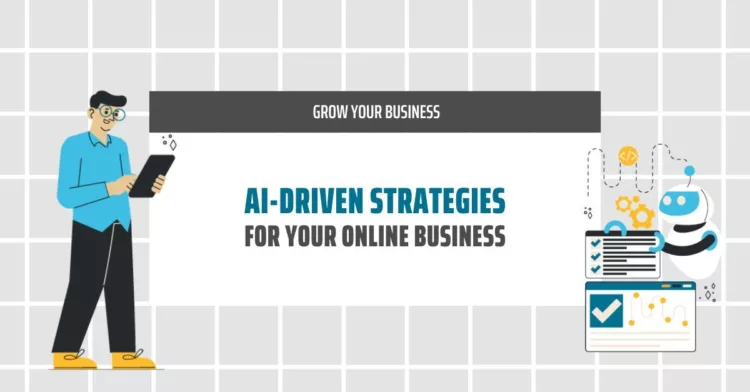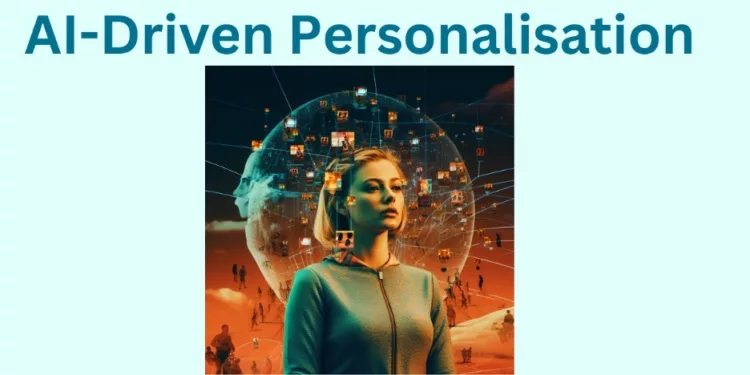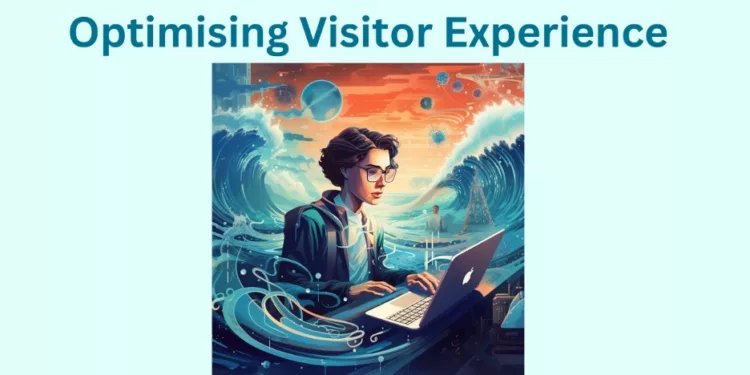AI's Role in Tailoring Your Web Journey

Did you know that "80% of consumers are more likely to make a purchase when brands offer personalised experiences" (Epsilon, 2018).
This eye-opening statistic might be met with one two reactions, either:
“oh great, I can adapt and stand out from my competition by creating a great experience for my customer”
or
“do I really need to? I don’t have the time or resources to even start thinking about this?
The first reaction is a resounding yes and for the second reaction – don’t worry, enter AI, or Artificial Intelligence, the game-changer your online business has been waiting for.
Why 'One-Size-Fits-All' is Outdated in the Digital World
The days of generic, one-size-fits-all web experiences are long gone. In the age of information overload, your audience craves a customised web experience that speaks directly to them. And that's where AI comes into play.
By leveraging AI for user experience, you're not just keeping up with the times; you're making sure your marketing strategy is staying ahead of the curve. This article will arm you with the knowledge and tools you need to implement AI-driven strategies that will revolutionise your visitor experience optimisation.
So, are you ready to ditch the one-size-fits-all approach and embrace the future of customised web experiences? Keep reading to find out how.
The Nuts and Bolts of AI-Driven Personalisation: A Deep Dive
How do you scale this personal touch to reach hundreds, thousands, or even millions of users? The answer lies in learning how to use the various AI tools available properly so that you can utilise their full potential into your strategy.
In this section, we'll peel back the layers of this fascinating technology, offering you real-world examples and actionable insights to elevate your visitor experience optimisation.

Real-life example: Amazon's Recommendation Engine
One of the most iconic examples of AI-driven personalisation in action is Amazon's recommendation engine. Utilising a technique known as collaborative filtering, Amazon analyses your past purchases and browsing history to suggest products that you're likely to be interested in. It's like having a personal shopper who knows your taste better than you do!
Categories of AI Tools for Personalisation
When it comes to AI tools that can help you with personalisation, there are several categories to consider:
- Data Analytics Tools: Brands like Google Analytics and Adobe Analytics offer AI-powered insights into customer behaviour.
- Chatbots: Platforms like Drift and Intercom use AI to provide real-time, personalized customer service.
- Content Recommendation Engines: Think of Taboola or Outbrain, which use AI to suggest relevant content to your visitors.
How This Can Be Applied: Leveraging Brand Solutions for Targeted Marketing
So, how can you harness the power of AI for your own website? The first step is to gather and analyse customer data. Brands like Google Analytics offer AI-driven tools that can sift through mountains of data to identify patterns and preferences. Once you have these insights, you can use them for targeted marketing campaigns, offering each visitor a customised web experience that's as unique as they are.
By understanding the mechanics of AI-driven personalisation, you're well on your way to optimizing your visitor experience. The next section will explore how to scale these efforts without losing the personal touch.
Scaling Personalisation Without Losing Quality
Personalisation is great, but what happens when your user base grows from a few hundred to several thousand or even more?
The challenge lies in scaling your personalisation efforts without sacrificing the quality of the user experience. Let's explore how you can achieve this delicate balance.
Real-life example: Spotify's Discover Weekly Playlist
Spotify's Discover Weekly playlist is a prime example of scalable personalisation. Using a combination of collaborative filtering, natural language processing, and deep learning algorithms, Spotify curates a weekly playlist for each of its millions of users.
The result? A personalized music experience that scales without losing its touch.
Categories of AI Tools for Scalability
When it comes to scaling your personalisation efforts, consider these categories of AI tools:
- Lead Scoring: Effective lead scoring is also key to scaling your personalisation efforts. Lead scoring uses AI to analyze customer data and assign scores to leads based on criteria like demographics, behavior, and preferences. This allows you to identify and focus your efforts on high-value leads most likely to convert. Tools like Breadcrumbs use predictive lead scoring powered by AI to help companies scale personalisation across their entire sales funnel.
- Personalisation Platforms: Think of Dynamic Yield or Optimizely, which offer AI-powered solutions to personalize web content for a large user base.
- Customer Relationship Management (CRM): Salesforce and Soho CRM use AI to manage customer data and interactions at scale.
How This Can Be Applied: Utilizing AI Algorithms for Scalability
Once you've got the basics of personalisation down, the next step is to scale these efforts. AI tools from brands like HubSpot can automate your marketing campaigns, allowing you to reach a larger audience without manual intervention.
Similarly, personalisation platforms like Dynamic Yield can help you offer customised content to a large user base, all powered by AI algorithms.
By understanding how to scale your personalisation efforts without sacrificing quality, you're one step closer to mastering visitor experience optimisation. Stay tuned for the next section where we'll discuss optimizing various touchpoints through AI.
Optimising Visitor Experience Through AI
So, you've got the mechanics down and you've scaled your efforts—what's next?
The key to a truly exceptional visitor experience lies in the details, the various touchpoints where your audience interacts with your brand. Let's explore how AI can elevate these interactions to the next level.

Take, for example, the use of chatbots in online retail. Brands like Sephora and H&M use AI-powered chatbots to offer instant, personalised customer support. These chatbots can handle a range of queries, from product recommendations to order tracking, providing a seamless customer experience.
Categories of AI Tools for Optimising Visitor Experience
Here are some AI tool categories that can help you optimize various touchpoints:
- Customer Support Tools: Platforms like Zendesk and Freshdesk use AI to automate customer service tasks and offer personalized support.
- Search and Navigation Tools: Algolia and Elasticsearch provide AI-powered search functionalities that make it easier for visitors to find what they're looking for.
- Behavioural Email Targeting: Brands like Mailchimp and SendinBlue use AI to analyse user behaviour and send targeted emails.
How This Can Be Applied: Implementing AI Chatbots and More
AI chatbots from platforms like Zendesk can offer instant, personalised customer support, improving your website's overall visitor experience. But don't stop there. Consider implementing AI-powered search functionalities from brands like Algolia to help your visitors find what they're looking for more easily.
By focusing on these various touchpoints, you're not just improving the user experience; you're optimising the entire visitor journey. And that's what AI-driven personalisation is all about.
The Future is Personalised: Are You Ready?
In this article, we've taken a comprehensive journey through the landscape of AI-driven personalisation. Let's recap what we've learned:
- The Mechanics of AI-Driven Personalisation: We started by diving into the algorithms and machine learning models that power personalisation. We looked at Amazon's recommendation engine as a real-world example and discussed how AI tools in categories like data analytics and chatbots can be leveraged for targeted marketing.
- Scaling Personalisation Without Losing Quality: Scaling is often the Achilles' heel of personalisation efforts, but it doesn't have to be. We explored how Spotify's Discover Weekly playlist maintains its quality while serving millions of users. We also discussed AI tools in automated marketing and personalisation platforms that can help you scale your efforts effectively.
- Optimising Visitor Experience Through AI: Finally, we examined the various touchpoints where AI can make a difference, from customer support to search functionalities. We highlighted the role of AI tools in customer support, search and navigation, and behavioural email targeting, offering a holistic approach to optimising the entire visitor journey.
The future of online business is not just personalised; it's AI-personalised. The technology exists, the tools are available, and the benefits are clear. Are you ready to transform your online business and offer a truly unique and engaging experience to your visitors?
A personalised web journey starts with the right domain name. Secure yours today with EuroDNS and implement the AI strategies we've discussed to create tailored experiences that not only engage customers but also drive conversions.
The Importance of the Social Customer Experience to Small Businesses
Related articles:
